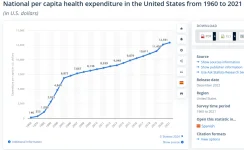- Joined
- Aug 10, 2013
- Messages
- 25,430
- Reaction score
- 32,337
- Location
- Cambridge, MA
- Gender
- Male
- Political Leaning
- Slightly Liberal
After all the hubbub in the early Obama years about whether the Affordable Care Act would--or even could--deliver on the promise of 'bending the cost curve,' it strikes me as very odd that there's been so little discussion of what happened next now that we have tons of data and hindsight to go on. Namely, the fact that the cost curve did bend and has been essentially flat for almost a decade and a half now (except for a transient COVID spike). Needless to say, that's a first and even the ACA's biggest boosters thirteen years ago weren't predicting that would happen.
Zeke Emanuel, to his credit, is one of the few people who does consistently talk about this and he's got a good op-ed today in STAT on the possible causes for this unprecedented state of affairs.
He gives a lot of the credit to the ACA-fueled efforts to change the way care is paid for and delivered (increasingly making health care providers accountable for the value of the care they're delivering)--which is also an under-discussed/reported on aspect of things. That's a pretty emphatic refutation of the (erroneous) point some folks used to make that "Obamacare is only about coverage, not health care!"
Zeke Emanuel, to his credit, is one of the few people who does consistently talk about this and he's got a good op-ed today in STAT on the possible causes for this unprecedented state of affairs.
He gives a lot of the credit to the ACA-fueled efforts to change the way care is paid for and delivered (increasingly making health care providers accountable for the value of the care they're delivering)--which is also an under-discussed/reported on aspect of things. That's a pretty emphatic refutation of the (erroneous) point some folks used to make that "Obamacare is only about coverage, not health care!"
For decades the growth in health care spending in the U.S. exceeded overall inflation — until relatively recently. With the exception of 2020 and the Covid cost spike, health care costs have remained at or below 18% of GDP since the enactment of the Affordable Care Act in 2010. This has been the longest stretch of no-cost-growth since at least 1965 and the enactment of Medicare and Medicaid. These overall numbers have been reinforced by reports that Medicare’s spending per person has been flat for more than a decade, and recent data showing that premiums for private employer-sponsored insurance have been increasing at 3.7% in the past decade, which is much slower than the 8.4% between 1999 and 2011.
When the ACA passed more than a decade ago, few orthopedists — indeed, few physicians — were interested in overall health care costs, much less assuming the initiative and responsibility for reducing them. During the ACA debate, the American Medical Association’s lobbying focused on getting higher physician payments by eliminating the Sustainable Growth Rate that each year threatened massive physician pay cuts.
Today, controlling costs is on every orthopedist’s mind, and they are not alone. The mindset of American physicians and other clinicians has changed, from ignoring costs to trying to cut them. Instead of figuring out more expensive medical tests and treatments, doctors are now asking whether a test or treatment will improve a patient’s health and how a service can be performed more efficiently by shifting where and how it is administered.
The catalyst for this change in attitude is payment-driven by the evolving shift from fee-for-service to value-based payment (VBP), from paying physicians to do more tests and treatments to paying them to improve health and prevent expensive disease exacerbations. In fact, CMMI was responsible for shifting Medicare from essentially no value-based payments — in which providers are responsible for quality and total cost of care — in 2012 to more than 30% of payments by 2016. This was the largest shift in Medicare payment in history and was a catalyst for change in the broader health care system.
Similarly, a decade ago a government program called MSSP ACOs — Medicare Shared Savings Program for Accountable Care Organizations — incentivized physicians to manage their patients, particularly their sickest patients, to preempt exacerbations that sent them to the emergency room and into hospital beds. Physician groups in this program began getting data on how they practiced medicine, who their sickest patients were, and began changing how they cared for the patients.




